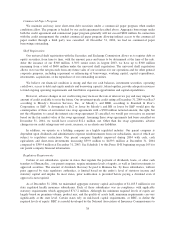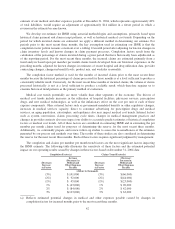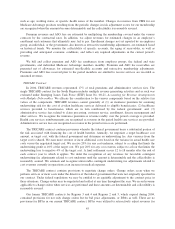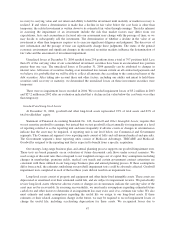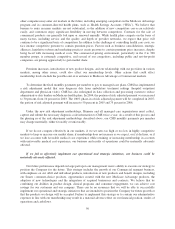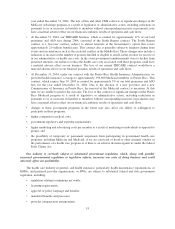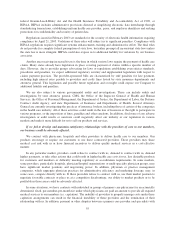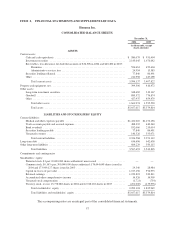Humana 2004 Annual Report Download - page 57
Download and view the complete annual report
Please find page 57 of the 2004 Humana annual report below. You can navigate through the pages in the report by either clicking on the pages listed below, or by using the keyword search tool below to find specific information within the annual report.recovery to carrying value and our intent and ability to hold the investment until maturity or market recovery is
realized. If and when a determination is made that a decline in fair value below the cost basis is other than
temporary, the related investment is written down to its estimated fair value through earnings. The risks inherent
in assessing the impairment of an investment include the risk that market factors may differ from our
expectations; facts and circumstances factored into our assessment may change with the passage of time; or we
may decide to subsequently sell the investment. The determination of whether a decline in the value of an
investment is other than temporary requires us to exercise significant diligence and judgment. The discovery of
new information and the passage of time can significantly change these judgments. The status of the general
economic environment and significant changes in the national securities markets influence the determination of
fair value and the assessment of investment impairment.
Unrealized losses at December 31, 2004 resulted from 254 positions from a total of 797 positions held. Less
than 4% of the carrying value of our consolidated investment securities have been in an unrealized loss position
greater than one year. The unrealized losses at December 31, 2004 generally can be attributed to changes in
interest rates. All issuers of securities trading at an unrealized loss remain current on all contractual payments and
we believe it is probable that we will be able to collect all amounts due according to the contractual terms of the
debt securities. After taking into account these and other factors, including our ability and intent to hold these
securities until recovery or maturity, we determined the unrealized losses on these investment securities were
temporary.
There were no impairment losses recorded in 2004. We recorded impairment losses of $3.2 million in 2003
and $27.2 million in 2002 after an evaluation indicated that a decline in fair value below the cost basis was other
than temporary.
Goodwill and Long-lived Assets
At December 31, 2004, goodwill and other long-lived assets represented 23% of total assets and 63% of
total stockholders’ equity.
Statement of Financial Accounting Standards No. 142, Goodwill and Other Intangible Assets, requires that
we not amortize goodwill to earnings, but instead that we test goodwill at least annually for impairment at a level
of reporting referred to as the reporting unit and more frequently if adverse events or changes in circumstances
indicate that the asset may be impaired. A reporting unit is one level below our Commercial and Government
segments. The Commercial segment’s two reporting units consist of fully and self-insured medical and specialty.
The Government segment’s three reporting units consist of Medicare Advantage, TRICARE and Medicaid.
Goodwill is assigned to the reporting unit that is expected to benefit from a specific acquisition.
Our strategy, long-range business plan, and annual planning process supports our goodwill impairment tests.
These tests are based primarily on an evaluation of future discounted cash flows under several scenarios. We
used a range of discount rates that correspond to our weighted-average cost of capital. Key assumptions including
changes in membership, premium yields, medical cost trends and certain government contract extensions are
consistent with those utilized in our long-range business plan and annual planning process. If these assumptions
differ from actual, the estimates underlying our goodwill impairment tests could be adversely affected. Goodwill
impairment tests completed in each of the last three years did not result in an impairment loss.
Long-lived assets consist of property and equipment and other finite-lived intangible assets. These assets are
depreciated or amortized over their estimated useful life, and are subject to impairment reviews. We periodically
review long-lived assets whenever adverse events or changes in circumstances indicate the carrying value of the
asset may not be recoverable. In assessing recoverability, we must make assumptions regarding estimated future
cash flows and other factors to determine if an impairment loss may exist, and, if so, estimate fair value. We also
must estimate and make assumptions regarding the useful life we assign to our long-lived assets. If these
estimates or their related assumptions change in the future, we may be required to record impairment losses or
change the useful life, including accelerating depreciation for these assets. We recognized losses due to
47



